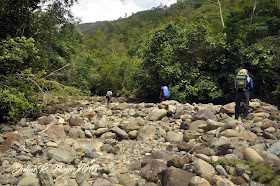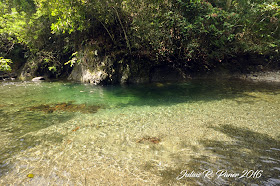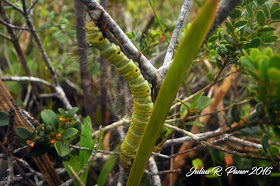Aside from being the
oldest town in Davao del Sur, I have known very few literature and equally few
interest about my hometown’s history. Not until portions of Mt. Apo were burned
last March. As a Tourism Officer I had to look for other tourism products to give
alternative reasons for people to visit to this place other than climbing the
highest mountain in the country.
As I gained curiosity
with the history of Sta. Cruz based on further readings and personal
interactions with some key informants in the town, I learned that ours is
perhaps one of the most colourful in the entire Mindanao. The municipality of
Sta. Cruz was an active participant in the making of Mindanao’s and Philippines’
histories. From the Spanish rule, to American regime, to Japanese occupation, to
Philippine Independence, to Martial Law, to EDSA Revolution, Sta. Cruz’ story was
intricately interwoven into the country’s saga.
This gulf town was
originally called “Labo,” a Bagobo word which means “marshland”. Labo is
situated between a confluence of two mountain streams where water were as clear
as crystal and was but a short distance from the coast. Long before the
Spaniards came, the Lumads or the natives Bagobo-Tagabawa inhabited Sta. Cruz
that was mostly forested except in the Darong coast. More than a century-old
municipality, Sta. Cruz was legally created last October 5, 1884 and it is the
third oldest town in Mindanao.
According to pioneers,
Sta. Cruz originated its name way back in 1880 when Spaniards planted a big
cross under a shelter upon their failure to Christianize the settlers who
continued to resist them. Another group of migrants settled adjacent to the
cross which was near the municipal building site, the place came to be known as
“SA CRUZ” which means “AT THE CROSS”. Official records from Manila Archives
also described how Sta. Cruz got its name during the Spanish administration. It
was documented that on October 4, 1884, Angel Rodriguez, Spanish Governor
General of Mindanao Province arrived on board the warship “Garduqui” escorted
by a sergeant, corporal and twelve persons from the capital detachment. They
were greeted by both Christians and non-Christians bringing with them banners
bearing the embroidered word STA. CRUZ. The next day (October 5), Rodriguez
blessed the town STA. CRUZ SA MINDANAO. The territorial lands of Sta. Cruz
prior to the division of Davao Province included municipalities of Digos, Bansalan,
Magsaysay, Matanao, Kiblawan, Hagonoy, Sulop, Malalag and Sta. Maria.
Sta. Cruz might have a
vibrant history but it is not supported with a very informative remainder. It
is in this reason that I started looking for remnants all over the town. In
April this year I had a personal quest to photo-document historical leftovers and
validated each one of them through the inscribed records from all possible
sources. And when we had our preparation for the 132nd Foundation
Anniversary of the town, I tapped the dynamic group Davao Photographers Club
(DPC) to help me in doing the job. We came up with a photo exhibit last October
1-5 and eagerly called it KAGIKAN showcasing photos of old structures and people
in Sta. Cruz.
At this point, I would
like to share some of my shots of old places and structures I gathered for
almost seven months. The corresponding literature are a product of my eccentric
researches and personal conversations with the direct families of the owners.
Municipal
Hall Building. The
Municipal Hall of Sta. Cruz is the very first town hall built in the entire
Davao del Sur province. It was erected in 1938 during the administration of
Mayor Mariano Pejo simultaneous with the other two structures Jose Rizal
Monument and the Don Mariano Pejo Park Fountain. These structures were built by Marble Works
Construction Company. In front of the building was the same site where Spanish
evangelizers arrived on board the warship “Gardoqui” led by Angel Rodriguez, a
Politico General of Davao Province way back 1884.
Doña
Matea Ancestral House.
Established in 1930, Doña Matea Almendras-Ralota Ancestral House is one of the
few ancient structures attesting that Sta. Cruz is the mother town of the
province of Davao del Sur. It is located in Poblacion Zone 3. A migrant from
Cebu, Doña Matea remarried to Bendigo and became matriarch to a clan of
politicians namely: Almendras, Bendigo, Ralota and Cagas.
San
Pedro Chapel Tuban. This
edifice in Baybay, Tuban is said to be the foundation of Gagmayng Kristohanong
Katilingban (GKK) in the history of the Roman Catholic Church in the world. A
celebration of Holy Eucharist being administered by a PSL (Pangulo sa
Liturhiya) was first held here on year 1957.
Dean
Old House. This
house was built in 1920s by the first appointed mayor of Davao del Sur Don
Ciriaco Godoy. Godoy’s only daughter Doña Indeng married to a Dean husband
which eventually made the house an ancestral abode of the Deans until today. During
the World War II, the family transferred to Matan-ao and the Japanese soldiers
occupied the house as their headquarters. When the Americans came, the family
also reoccupied the house.
Melilia
UCCP Mission School.
This is the first structure after the Thomasites led by American missionary
Rev. Robert Black introduced Protestantism. Black first preached the gospel to
the Bagobos in Melilia in 1904 and it consequently became the bastion of United
Church of Christ in the Philippines (UCCP) and from it hailed the founders of
Brokenshire Hospital of Davao and the Siliman University. The actual
establishment of this structure was year 1909. It was called Robert Black
Mission School where Maximiano
Tongcaling became the first Bagobo preacher.
Tuban
Old Cluster Houses. This
cluster of houses situated along the national highway of Barangay Tuban was
built in 1950s by the early settlers of the place from a prominent clan of the
Aguilar and Carriedo. Some older houses located in the opposite side are owned
by some half-blooded Chinese as first settlers of the place.
Tan
Kim Kee Estate Old Farm House.
The house was built in 1911 primarily to be used as vantage site in monitoring
the farm workers and the physical status of the Tan Kim Kee agricultural
production area, who were among the families to have been allowed by the
American Commonwealth to own cadastral property in Sta. Cruz per Cadastral
Survey No. 275 paving the way for granting property rights. The highest mark of
the house allowed the farm manager to oversee production of the wide area of
coconut and cattle ranch. Owned by the Chinese Lim clan, Tan Kim Kee Estate is
the largest agricultural area in the southern part of Sta. Cruz. From it was
also a coconut solar dryer assembled which, according to pioneering farm workers,
was converted by the Japanese soldiers into a salt warehouse as provocative
site for their captives during the Japanese period.
Saez Spanish House in Darong. This house was built in 1940s by Don Eliseo Saez, a Spaniard who came from Burgos, Spain. Before the coming of Don Eliseo, his brother Don Marcos Saez already owned a vast agricultural plantation. The Saez brothers were among the Spaniards who settled in Darong, which became the biggest Spanish Community in Southern Philippines if not Mindanao.
Balay
ni Nonoy Pension House.
The house was first built in 1950s that served as the home of former Mayor
Amancio Bendigo. It was renovated in 1970s and now being used commercially as a
pension house and office of the family’s real estate business.
Patulangon
Old Guttierez House.
This structure housed the Guttierez Family in Patulangon, Barangay Zone 1. It
was erected in 1926. The Guttierez were among the early settlers in the town
with Spanish roots led by their great grandfather Don Sergio Guttierez who
hailed from Santander, Spain.
St.
Joseph The Worker Parish.
In the course of erecting new parishes in 1940 upon the request of Bishop Luis
del Rosario, SJ, DD as part of their evangelization efforts in Mindanao; the
St. Joseph The Worker Parish was established in Sta. Cruz (then still the
entire Davao del Sur) along with the parish of Kingking. The first Parish
Priest was Fr. Leo Poirier, PME and the
Assistant Parish Priest was Fr. Omer Leblanc, PME. The formal establishment of
the parish structure was May 1941. Unfortunately, war broke out in December
1941 and the two priests fled to the mountains but later surrendered to the
Japanese but were eventually killed in 1942 by the Japanese soldiers in Pikit,
Cotabato. Although the parish has a new structure now during its 75th
Jubilee celebration, St. Joseph The Worker Parish is a major contributor to the
overall historical timeline of the Municipality of Sta. Cruz.
There are still many
structures around the town but I have yet to visit them one by one because of
time constraint. The Spanish houses in Astorga and Coronon are my next
target and the old residents of the previous mayors in Sta. Cruz.
Truly, we have a rich
history unfolding and with the LGU’s drive to encourage the owners of these
structures to preserve them we could launch another interesting tourism product
with history as the theme.























































